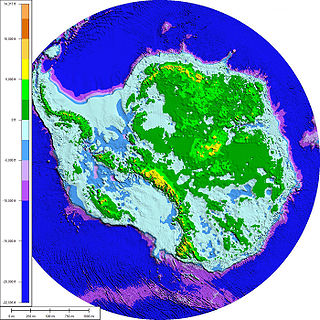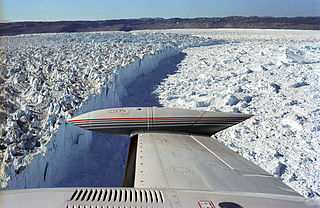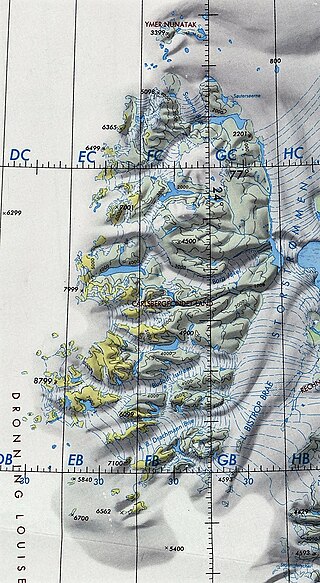Related Research Articles

Greenland is located between the Arctic Ocean and the North Atlantic Ocean, northeast of Canada and northwest of Iceland. The territory comprises the island of Greenland—the largest island in the world—and more than a hundred other smaller islands. Greenland has a 1.2 kilometre long border with Canada on Hans Island. A sparse population is confined to small settlements along certain sectors of the coast. Greenland possesses the world's second-largest ice sheet.

An ice shelf is a large floating platform of ice that forms where a glacier or ice sheet flows down to a coastline and onto the ocean surface. Ice shelves are only found in Antarctica, Greenland, Northern Canada, and the Russian Arctic. The boundary between the floating ice shelf and the anchor ice that feeds it is the grounding line. The thickness of ice shelves can range from about 100 m (330 ft) to 1,000 m (3,300 ft).

The Eemian was the interglacial period which began about 130,000 years ago at the end of the Penultimate Glacial Period and ended about 115,000 years ago at the beginning of the Last Glacial Period. It corresponds to Marine Isotope Stage 5e. Although sometimes referred to as the "last interglacial", it was the second-to-latest interglacial period of the current Ice Age, the most recent being the Holocene which extends to the present day. The prevailing Eemian climate was, on average, around 1 to 2 degrees Celsius warmer than that of the Holocene. During the Eemian, the proportion of CO2 in the atmosphere was about 280 parts per million.

The Western Antarctic Ice Sheet (WAIS) is the segment of the continental ice sheet that covers West Antarctica, the portion of Antarctica on the side of the Transantarctic Mountains that lies in the Western Hemisphere. The WAIS is classified as a marine-based ice sheet, meaning that its bed lies well below sea level and its edges flow into floating ice shelves. The WAIS is bounded by the Ross Ice Shelf, the Ronne Ice Shelf, and outlet glaciers that drain into the Amundsen Sea.

The Greenland ice sheet is a body of ice with the thickness of about 1.67 km (1.0 mi) on average, and almost 3.5 km (2.2 mi) at its thickest point. It is almost 2,900 kilometres (1,800 mi) long in a north–south direction, with the greatest width of 1,100 kilometres (680 mi) at a latitude of 77°N, near its northern margin. It covers 1,710,000 square kilometres (660,000 sq mi), around 80% of the surface of Greenland, and is the second largest body of ice in the world, after the East Antarctic ice sheet. It is sometimes referred to as an ice cap, or under the term inland ice, or its Danish equivalent, indlandsis. The acronyms GIS or GrIS are also frequently used in the scientific literature.

A subglacial lake is a lake that is found under a glacier, typically beneath an ice cap or ice sheet. Subglacial lakes form at the boundary between ice and the underlying bedrock, where gravitational pressure decreases the pressure melting point of ice. Over time, the overlying ice gradually melts at a rate of a few millimeters per year. Meltwater flows from regions of high to low hydraulic pressure under the ice and pools, creating a body of liquid water that can be isolated from the external environment for millions of years.
Ice algae are any of the various types of algal communities found in annual and multi-year sea, and terrestrial lake ice or glacier ice.

An ice stream is a region of fast-moving ice within an ice sheet. It is a type of glacier, a body of ice that moves under its own weight. They can move upwards of 1,000 metres (3,300 ft) a year, and can be up to 50 kilometres (31 mi) in width, and hundreds of kilometers in length. They tend to be about 2 km (1.2 mi) deep at the thickest, and constitute the majority of the ice that leaves the sheet. In Antarctica, the ice streams account for approximately 90% of the sheet's mass loss per year, and approximately 50% of the mass loss in Greenland.

Jakobshavn Glacier, also known as Ilulissat Glacier, is a large outlet glacier in West Greenland. It is located near the Greenlandic town of Ilulissat and ends at the sea in the Ilulissat Icefjord.

The retreat of glaciers since 1850 is well documented and is one of the effects of climate change. The retreat of mountain glaciers, notably in western North America, Asia, the Alps and tropical and subtropical regions of South America, Africa and Indonesia, provide evidence for the rise in global temperatures since the late 19th century. The acceleration of the rate of retreat since 1995 of key outlet glaciers of the Greenland and West Antarctic ice sheets may foreshadow a rise in sea level, which would affect coastal regions. Excluding peripheral glaciers of ice sheets, the total cumulated global glacial losses over the 26-year period from 1993 to 2018 were likely 5500 gigatons, or 210 gigatons per yr.
Radioglaciology is the study of glaciers, ice sheets, ice caps and icy moons using ice penetrating radar. It employs a geophysical method similar to ground-penetrating radar and typically operates at frequencies in the MF, HF, VHF and UHF portions of the radio spectrum. This technique is also commonly referred to as "Ice Penetrating Radar (IPR)" or "Radio Echo Sounding (RES)".

Glacier morphology, or the form a glacier takes, is influenced by temperature, precipitation, topography, and other factors. The goal of glacial morphology is to gain a better understanding of glaciated landscapes and the way they are shaped. Types of glaciers can range from massive ice sheets, such as the Greenland ice sheet, to small cirque glaciers found perched on mountain tops. Glaciers can be grouped into two main categories:

Richard Blane Alley is an American geologist and Evan Pugh Professor of Geosciences at Pennsylvania State University. He has authored more than 240 refereed scientific publications about the relationships between Earth's cryosphere and global climate change, and is recognized by the Institute for Scientific Information as a "highly cited researcher."

Major environmental issues caused by contemporary climate change in the Arctic region range from the well-known, such as the loss of sea ice or melting of the Greenland ice sheet, to more obscure, but deeply significant issues, such as permafrost thaw, as well as related social consequences for locals and the geopolitical ramifications of these changes. The Arctic is likely to be especially affected by climate change because of the high projected rate of regional warming and associated impacts. Temperature projections for the Arctic region were assessed in 2007: These suggested already averaged warming of about 2 °C to 9 °C by the year 2100. The range reflects different projections made by different climate models, run with different forcing scenarios. Radiative forcing is a measure of the effect of natural and human activities on the climate. Different forcing scenarios reflect things such as different projections of future human greenhouse gas emissions.

In climate science, a tipping point is a critical threshold that, when crossed, leads to large, accelerating and often irreversible changes in the climate system. If tipping points are crossed, they are likely to have severe impacts on human society and may accelerate global warming.

Ice sheet dynamics describe the motion within large bodies of ice such as those currently on Greenland and Antarctica. Ice motion is dominated by the movement of glaciers, whose gravity-driven activity is controlled by two main variable factors: the temperature and the strength of their bases. A number of processes alter these two factors, resulting in cyclic surges of activity interspersed with longer periods of inactivity, on both hourly and centennial time scales. Ice-sheet dynamics are of interest in modelling future sea level rise.

Greenland's climate is a tundra climate on and near the coasts and an ice cap climate in inland areas. It typically has short, cool summers and long, moderately cold winters.

Storstrommen, is one of the major glaciers in northeastern Greenland. The North-East Greenland Ice Stream (NEGIS) discharges into 3 main marine-terminating outlets: 79N Glacier, Zachariae Isstrøm and Storstrommen - as arranged North to South.
Jacob Sebastian Haugaard Mernild is a Danish professor in climate change, glaciology and hydrology, who is the pro-vice-chancellor of the University of Southern Denmark. Mernild has been an Intergovernmental Panel on Climate Change (IPCC) author for the United Nations since 2010. Initially a contributing author on the IPCC Fifth Assessment Report, he was lead author on the IPCC Sixth Assessment Report.
Marika Holland is a scientist at the National Center for Atmospheric Research known for her work on modeling sea ice and its role in the global climate.
References
- 1 2 "Twila Moon CV at congress.gov" (PDF). congress.gov. Retrieved March 1, 2022.
- ↑ Moon, Twila; Joughin, Ian R (2014). Greenland outlet glacier behavior during the 21st century: understanding velocities and environmental factors (Thesis). hdl:1773/26278. OCLC 897830094.
- ↑ "Moon's website".
- ↑ Moon, Twila; Joughin, Ian (2008-06-07). "Changes in ice front position on Greenland's outlet glaciers from 1992 to 2007". Journal of Geophysical Research. 113 (F2): F02022. Bibcode:2008JGRF..113.2022M. doi: 10.1029/2007JF000927 . ISSN 0148-0227.
- ↑ Moon, Twila A.; Gardner, Alex S.; Csatho, Beata; Parmuzin, Ivan; Fahnestock, Mark A. (2020). "Rapid Reconfiguration of the Greenland Ice Sheet Coastal Margin". Journal of Geophysical Research: Earth Surface. 125 (11). Bibcode:2020JGRF..12505585M. doi:10.1029/2020JF005585. ISSN 2169-9003. S2CID 228967718.
- ↑ Moon, T.; Joughin, I.; Smith, B.; Howat, I. (2012-05-04). "21st-Century Evolution of Greenland Outlet Glacier Velocities". Science. 336 (6081): 576–578. Bibcode:2012Sci...336..576M. doi:10.1126/science.1219985. ISSN 0036-8075. PMID 22556249. S2CID 34158909.
- ↑ Moon, T.; Sutherland, D. A.; Carroll, D.; Felikson, D.; Kehrl, L.; Straneo, F. (2018). "Subsurface iceberg melt key to Greenland fjord freshwater budget". Nature Geoscience. 11 (1): 49–54. Bibcode:2018NatGe..11...49M. doi:10.1038/s41561-017-0018-z. ISSN 1752-0894. S2CID 134343785.
- ↑ Moon, Twila; Scambos, Ted; Abdalati, Waleed; Ahlstrøm, Andreas P.; Bindschadler, Robert; Gambill, Jill; Heimbach, Patrick; Hock, Regine; Langley, Kirsty; Miller, Ian; Truffer, Martin (2020-09-02). "Ending a Sea of Confusion: Insights and Opportunities in Sea-Level Change Communication". Environment: Science and Policy for Sustainable Development. 62 (5): 4–15. doi: 10.1080/00139157.2020.1791627 . ISSN 0013-9157. S2CID 221300355.
- ↑ Straneo, Fiammetta; Sutherland, David A.; Stearns, Leigh; Catania, Ginny; Heimbach, Patrick; Moon, Twila; Cape, Mattias R.; Laidre, Kristin L.; Barber, Dave; Rysgaard, Søren; Mottram, Ruth (2019-03-29). "The Case for a Sustained Greenland Ice Sheet-Ocean Observing System (GrIOOS)". Frontiers in Marine Science. 6: 138. doi: 10.3389/fmars.2019.00138 . ISSN 2296-7745.
- ↑ Moon, Twila; Ahlstrøm, Andreas; Goelzer, Heiko; Lipscomb, William; Nowicki, Sophie (2018). "Rising Oceans Guaranteed: Arctic Land Ice Loss and Sea Level Rise". Current Climate Change Reports. 4 (3): 211–222. doi:10.1007/s40641-018-0107-0. ISSN 2198-6061. PMC 6428231 . PMID 30956936.
- ↑ "What The Melting Of Greenland's Ice Sheet Means For Sea Levels". All Things Considered, National Public Radio. August 1, 2019.
- ↑ "EARTH'S THERMOMETERS: GLACIAL AND ICE SHEET MELT IN A CHANGING CLIMATE". www.congress.gov. July 11, 2019. Retrieved 2022-03-02.
- ↑ "Ice on the edge of survival: Warming is changing the Arctic". KSTP. 6 November 2021.
- ↑ "A gloomy report card from the Arctic". NPR.org. December 14, 2021. Retrieved March 1, 2022.
- ↑ Kaplan, Sarah (December 14, 2021). "Climate change has destabilized the Earth's poles, putting the rest of the planet in peril". Washington Post. Retrieved March 1, 2022.
- ↑ Sakas, Michael Elizabeth. "Should Climate Scientists Be Climate Activists? One Tells Us 'We Can't Wait Any Longer' For Action". Colorado Public Radio. Retrieved 2022-03-02.